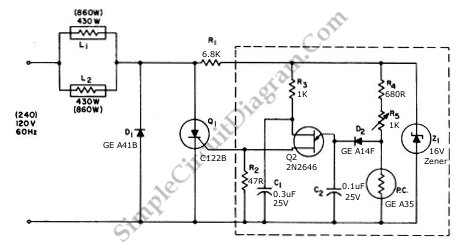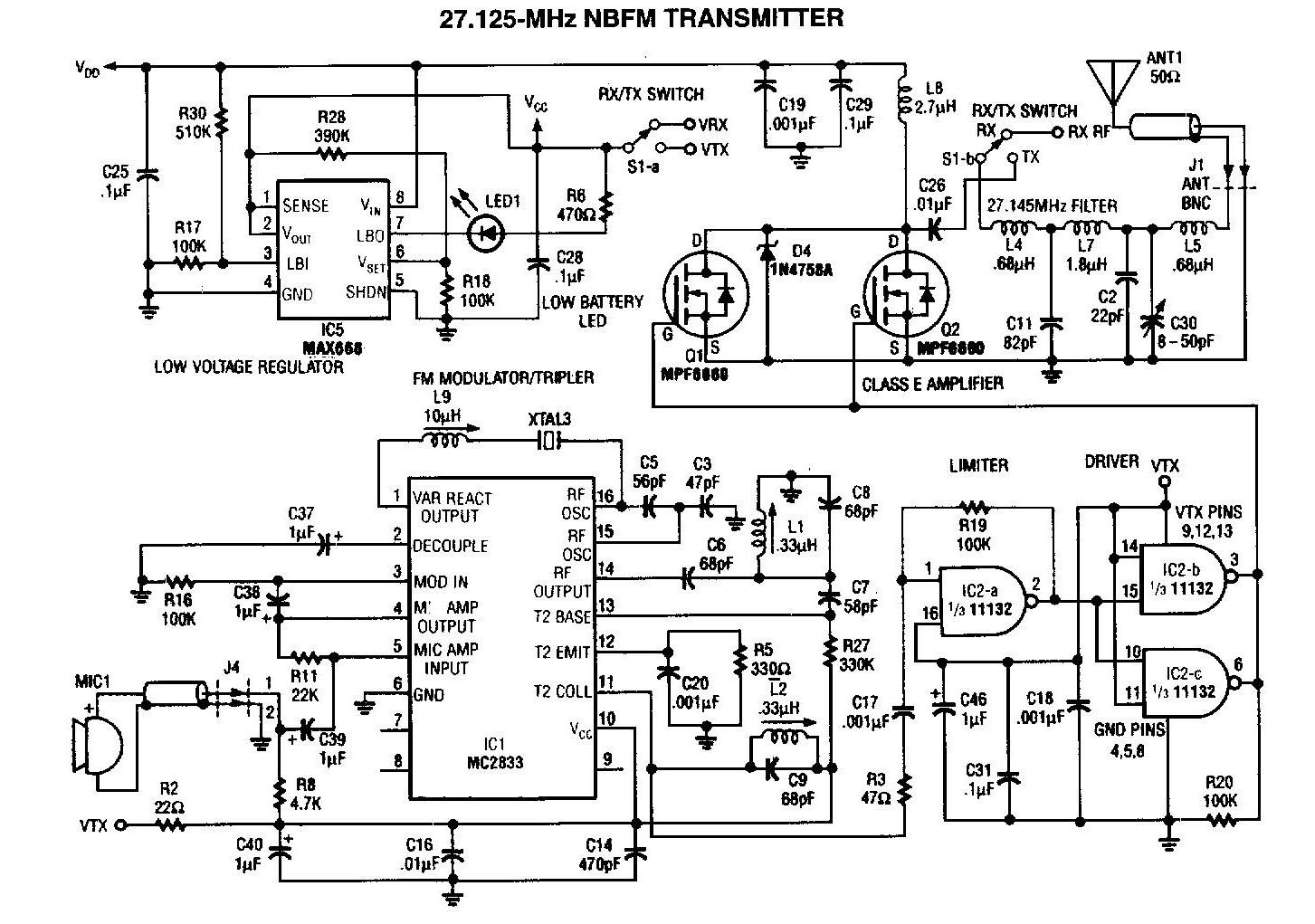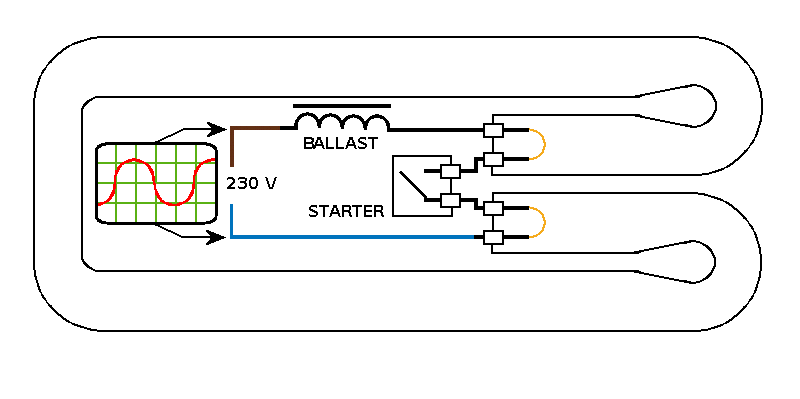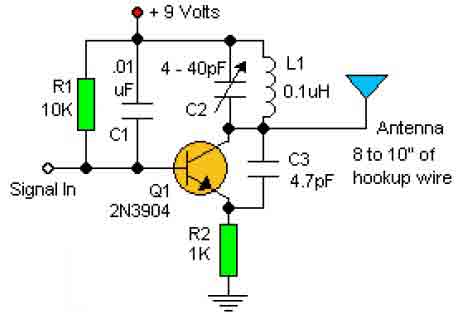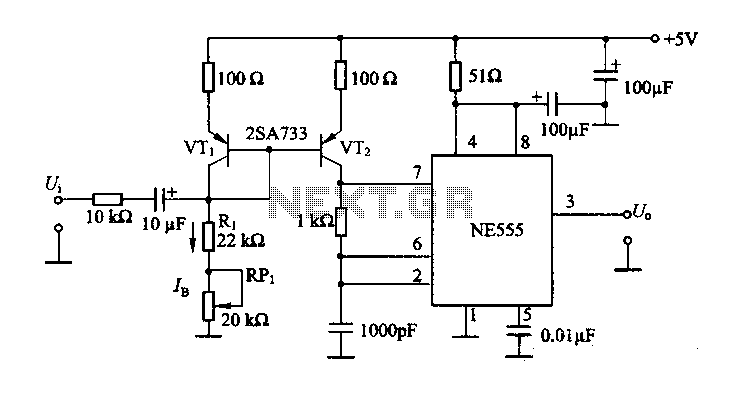
Light dimmer circuit
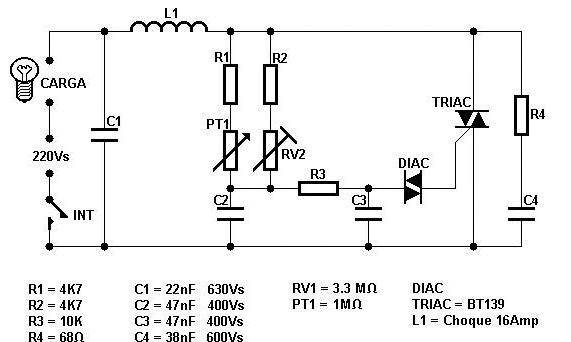
This circuit design has not been tested by staff. The design, as submitted by the designer, is believed to be correct; however, there is no guarantee of its accuracy. The content provided may be inaccurate, inappropriate, or misguided. There is no assurance regarding the suitability of the circuits and information for any purpose. Warning: This circuit operates at potentially lethal 220V AC mains voltage. It should only be built and used by individuals knowledgeable about safely working with such dangerous voltages and constructing the circuit to ensure safe operation. Solid-state light dimmers function by varying the "duty cycle" (on/off time) of the full AC voltage applied to the controlled lights. For instance, if voltage is applied for only half of each AC cycle, the light bulb will appear much dimmer than when it receives the full AC voltage, as it receives less power to heat the filament. Solid-state dimmers utilize the brightness knob setting to determine when to switch the light on and off during each voltage cycle. The precise timing of the triac's triggering in relation to the zero crossings of the AC power is critical in determining the power level to the light bulb. Once the triac is triggered, it continues to conduct until the current passing through it reaches zero (which occurs at the next zero crossing if the load is purely resistive, such as a light bulb). By adjusting the phase at which the triac is triggered, the duty cycle and thus the brightness of the light can be modified. The circuit incorporates a variable resistance formed by R1 + PT1 in parallel with R2 + RV2. This variable resistance, along with capacitors C1 and C2, creates a delay from the mains zero crossing to the firing point of the diac. The DIAC is a bidirectional trigger diode that conducts current only after its breakdown voltage (typically around 30V) has been momentarily exceeded. The larger the variable resistance feeding the capacitors, the longer it takes for the voltage across the capacitor to rise to the level necessary for the DIAC to fire, activating the triac TH1. The circuit is calibrated such that PT1 is initially set to the highest resistance value. The value of RV2 is adjusted to achieve the desired minimum brightness of the light bulb. After calibration, PT1 can be used to control the light bulb's brightness freely, ranging from maximum brightness to the set minimum. Capacitor C1 and inductor L1 form a simple radio frequency interference filter. Without this filter, the circuit would generate significant interference, as the triac firing in the middle of the AC phase results in rapid current surges. The triac BT139 utilized in the circuit is rated for a continuous current of 16A when adequately cooled with a large heat sink; the maximum current capacity decreases with reduced cooling. Components R4 and C4 create an RC snubber network that protects the TRIAC from spurious triggering.
This circuit schematic represents a solid-state light dimmer designed to modulate the brightness of incandescent lamps through phase control. The circuit operates on a 220V AC mains supply, which necessitates careful handling due to the potential hazards associated with high voltage. The primary component responsible for controlling the light output is the triac, which is triggered by a DIAC that conducts after its breakdown voltage is reached.
The circuit's operational principle hinges on the adjustment of the duty cycle, which is achieved by manipulating the variable resistances R1, PT1, R2, and RV2. This configuration allows for precise control over the timing of the triac's activation, thereby influencing the effective power delivered to the light bulb. Capacitors C1 and C2 play a critical role in establishing the timing delay necessary for the DIAC to fire, while also contributing to the overall stability of the circuit.
The inclusion of an RF interference filter, consisting of capacitor C1 and inductor L1, is essential for minimizing electromagnetic interference generated during the triac's operation. Additionally, the RC snubber network formed by R4 and C4 serves to protect the triac from unintended triggering due to voltage spikes, enhancing the reliability of the circuit.
To ensure optimal performance and safety, it is crucial that the circuit is calibrated correctly. The initial setup involves adjusting PT1 to its maximum resistance while setting RV2 to achieve the desired minimum brightness. This calibration step is vital for establishing a functional range for the dimmer, allowing for smooth transitions between different brightness levels.
The triac BT139, chosen for this application, provides robust performance under continuous operation, provided it is adequately heat-sinked. Careful attention to component ratings and thermal management is essential for maintaining circuit integrity and ensuring safe operation. This circuit design exemplifies the principles of phase control dimming, providing an efficient solution for adjustable lighting applications.This circuit design is not tested by staff. The circuit design as submitted by the designer is believed to be correct, but there is no guarantee of the correctness of the circuit design. The contents of the articles below might be totally inaccurate, inappropriate, or misguided. There is no guarantee as to the suitability of said circuits and information for any purpose. Warning: This circuit operates at potentially lethal 220V AC mains voltage. The circuit should be built and used only by people who know hot to safely work with such dangerous voltages and how to built the circuit so that it is safe to use. Solid-state light dimmers work by varying the "duty cycle" (on/off time) of the full AC voltage that is applied to the lights being controlled.
For example, if the voltage is applied for only half of each AC cycle, the light bulb will appear to be much less bright than when it get the full AC voltage, because it get`s less power to heat the filament. Solid-state dimmers use the brightness knob setting to determine at what point in each voltage cycle to switch the light on and off.
The exact time when the triac is triggered relative to the zero crossings of the AC power is used to determine the power level to the light bulb. When the the triac is triggered it keeps conducting until the current passing though it goes to zero (exactly at the next zero crossing if the load is purely resistive, like light bulb).
By changing the phase at which you trigger the triac you change the duty cycle and therefore the brightness of the light. The circuit contains a variable resistance that consists of R1 + PT1 in paralle with R2 + RV2. This variable resistance together with capacitors C1 and C2 form a delay from the mains zero crossing to the firing point of the diac.
DIAC is a bidirectional trigger diode that conducts current only after its breakdown voltage (typically around 30V) has been exceeded momentarily. The larger the variable resistance feeding the capacitors, the longer it takes for the voltage across the capacitor to rise to the point where the DIAC fires turning on the triac TH1.
The circuit is calibated in such way that first PT1 is turned to highest resistance values. The value of RV2 is turned in such position that the desired minumum brightness of the light bulb is reached. After this calibration the PT1 can be used to freely control the light bulb brightness at the desired control range form the maximum brightness to set minumum.
Capacitor C1 and inductor L1 make a simple radio frequency interference filter. Without it the circuit would generate quite much interference because firing of the triac in the middle of the AC phase causes fast rising current surges. The triac BT139 used in the circuit is rated for 16A continuous current when properly cooled with a large heat sink.
The maximum current is less with less cooling. The components R4 and C4 for a RC nubber network that protects TRIAC from spurious triggering. 🔗 External reference
This circuit schematic represents a solid-state light dimmer designed to modulate the brightness of incandescent lamps through phase control. The circuit operates on a 220V AC mains supply, which necessitates careful handling due to the potential hazards associated with high voltage. The primary component responsible for controlling the light output is the triac, which is triggered by a DIAC that conducts after its breakdown voltage is reached.
The circuit's operational principle hinges on the adjustment of the duty cycle, which is achieved by manipulating the variable resistances R1, PT1, R2, and RV2. This configuration allows for precise control over the timing of the triac's activation, thereby influencing the effective power delivered to the light bulb. Capacitors C1 and C2 play a critical role in establishing the timing delay necessary for the DIAC to fire, while also contributing to the overall stability of the circuit.
The inclusion of an RF interference filter, consisting of capacitor C1 and inductor L1, is essential for minimizing electromagnetic interference generated during the triac's operation. Additionally, the RC snubber network formed by R4 and C4 serves to protect the triac from unintended triggering due to voltage spikes, enhancing the reliability of the circuit.
To ensure optimal performance and safety, it is crucial that the circuit is calibrated correctly. The initial setup involves adjusting PT1 to its maximum resistance while setting RV2 to achieve the desired minimum brightness. This calibration step is vital for establishing a functional range for the dimmer, allowing for smooth transitions between different brightness levels.
The triac BT139, chosen for this application, provides robust performance under continuous operation, provided it is adequately heat-sinked. Careful attention to component ratings and thermal management is essential for maintaining circuit integrity and ensuring safe operation. This circuit design exemplifies the principles of phase control dimming, providing an efficient solution for adjustable lighting applications.This circuit design is not tested by staff. The circuit design as submitted by the designer is believed to be correct, but there is no guarantee of the correctness of the circuit design. The contents of the articles below might be totally inaccurate, inappropriate, or misguided. There is no guarantee as to the suitability of said circuits and information for any purpose. Warning: This circuit operates at potentially lethal 220V AC mains voltage. The circuit should be built and used only by people who know hot to safely work with such dangerous voltages and how to built the circuit so that it is safe to use. Solid-state light dimmers work by varying the "duty cycle" (on/off time) of the full AC voltage that is applied to the lights being controlled.
For example, if the voltage is applied for only half of each AC cycle, the light bulb will appear to be much less bright than when it get the full AC voltage, because it get`s less power to heat the filament. Solid-state dimmers use the brightness knob setting to determine at what point in each voltage cycle to switch the light on and off.
The exact time when the triac is triggered relative to the zero crossings of the AC power is used to determine the power level to the light bulb. When the the triac is triggered it keeps conducting until the current passing though it goes to zero (exactly at the next zero crossing if the load is purely resistive, like light bulb).
By changing the phase at which you trigger the triac you change the duty cycle and therefore the brightness of the light. The circuit contains a variable resistance that consists of R1 + PT1 in paralle with R2 + RV2. This variable resistance together with capacitors C1 and C2 form a delay from the mains zero crossing to the firing point of the diac.
DIAC is a bidirectional trigger diode that conducts current only after its breakdown voltage (typically around 30V) has been exceeded momentarily. The larger the variable resistance feeding the capacitors, the longer it takes for the voltage across the capacitor to rise to the point where the DIAC fires turning on the triac TH1.
The circuit is calibated in such way that first PT1 is turned to highest resistance values. The value of RV2 is turned in such position that the desired minumum brightness of the light bulb is reached. After this calibration the PT1 can be used to freely control the light bulb brightness at the desired control range form the maximum brightness to set minumum.
Capacitor C1 and inductor L1 make a simple radio frequency interference filter. Without it the circuit would generate quite much interference because firing of the triac in the middle of the AC phase causes fast rising current surges. The triac BT139 used in the circuit is rated for 16A continuous current when properly cooled with a large heat sink.
The maximum current is less with less cooling. The components R4 and C4 for a RC nubber network that protects TRIAC from spurious triggering. 🔗 External reference

